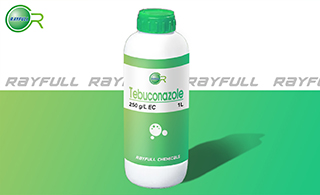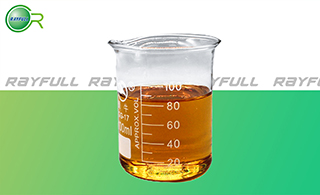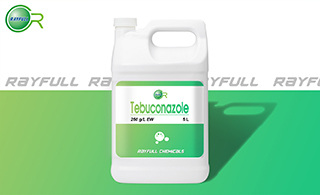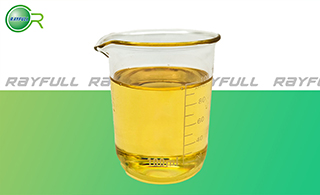Tebuconazole
    ОмЯтҙј ОмЯтҙј
Introduction: Tebuconazole is a trazole fungicide. It is taken up by plants and transported within tissues. It is used as a seed dressing, which works effectively against various smut and bunt diseases of cereals. As foliar spray tebuconazole controls numerous phathogens such as rust species, powdery mildew, and scale in various crops. It is also used to control pests including yellow leaf spot, black spot, net blotch, and Scelerotinia rot. Tebuconazole can be applied to control above mentioned diseases on cereals (including wheat, barley, oat, rye), grapes, peanuts, vegetables (onions and peas), bananas, sugarcane.
Common name: Tebuconazole
Another name: Folicur; Fenetrazole; Ethyltrianol; Terbuconazole; Terbutrazole; Etiltrianol; Elite; Raxil; Preventol A 8; LYNX; Tebuconazole [ISO]; BAY-HWG 1608; etc.
Chemical name: (RS)-1-p-chlorophenyl-4,4-dimethyl-3-(1H-1,2,4-triazol-1-ylmethyl)pentan-3-ol
Empirical formula: C16H22ClN3O
Structural formula:

Mol. Weight: 307.82 g/mol
CAS No.: 107534-96-3;
Specifications
Leading Tebuconazole supplier
Tebuconazole 95% TC
Tebuconazole 80% WP
Tebuconazole 250 g/L EC
Tebuconazole 250 g/L EW
Tebuconazole 120 g/L FS
Packing:
BULK PACKING
Powder: 25kg/Bag, 25kg/Drum, 50kg/Drum etc.
Liquid: 200L/Drum, 20L/Drum, 10L/Drum etc.
SMALL PACKING
Powder: 1kg/Alu bag, 500g/Alu bag, 200g/Alu bag, 100g/Alu bag, 50g/Alu bag, 15g/Alu bag etc.
Liquid: 5L/Drum, 1L/Bottle, 500ml/Bottle, 250ml/Bottle, 100ml/Bottle, 50ml/Bottle etc.
Customerized packing label
Tebuconazole FAO standard
Professional registration
HAZARDS IDENTIFICATION
Hazard statement(s)
H302 (100%): Harmful if swallowed.
H361 (100%): Suspected of damaging fertility or the unborn child.
H400 (17.71%): Very toxic to aquatic life.
H410 (17.71%): Very toxic to aquatic life with long lasting effects.
H411 (82.29%): Toxic to aquatic life with long lasting effects.
Precautionary statement(s)
P201: Obtain special instructions before use.
P202: Do not handle until all safety precautions have been read and understood.
P264: Wash ... thoroughly after handling.
P270: Do not eat, drink or smoke when using this product.
P273: Avoid release to the environment.
P281: Use personal protective equipment as required.
P301+P312: IF SWALLOWED: call a POISON CENTER/doctor/... IF you feel unwell.
P308+P313: IF exposed or concerned: Get medical advice/attention.
P330: Rinse mouth.
P391: Collect spillage.
P405: Store locked up.
P501: Dispose of contents/container to an approved waste disposal plant.
Supplemental Hazard Statements: none.
MAMMALIAN TOXICOLOGY
Acute toxicity: 1) Acute oral LD50 for rats is 1700 mg/kg. 2) Acute dermal LD50 for rats is >2000 mg/kg. 3) Acute inhalation toxicity LC50 (4 h) for rats is > 0.82 mg/l, dust (nose only). 4) Skin irritation: Non-irritating to skin (rabbits). 5) Eye irritation: Non-irritating to eyes (rabbits). 6) Skin sensitization for guinea pig: Not a sensitizer (Magnusson & Kligman and Buehler tests).
NOEL: (2 y) for rats is 15.9 mg/kg/day; (21 m) for mice is 5.9 mg/kg/day; (2 y) for dogs is 2.9 mg/kg/day. Other Not carcinogenic. Not genotoxic.
ADI (JMPR) 0-0.03 mg/kg b.w. [1994, 2010]
Classification:
WHO Classification: II (Moderately hazardous)
EC Risk Classification: Reproduction risk category 3: R63; Xn - Harmful: R22; N - Dangerous for the environment: R51, R53
US EPA Classification (formulation): II, III (Warning - Moderately toxic, Caution - Slightly toxic)
ECOTOXICOLOGY
Effect on birds: Acute oral LD50 for Bobwhite quail is 1988 mg/kg. Effect on fish: Acute LC50 (96 h) for Rainbow trout is 4.4 mg/l. Effects on aquatic invertebrates: Acute EC50 (48 h) for Daphnia magna is 0.01 mg/l. Effects on algae: Acute 72 hour EC50 for Scenedemus subspicatus is 1.96 mg/l. Effects on bees: contact acute 48 hour LD50 is >200 ҰМg/bee, oral acute 48 hour LD50 is >83.05 ҰМg/bee. Effects on earthworms: Acute 14 day LC50 is 1381 mg/kg.
ENVIRONMENTAL FATE
If released to air, a vapor pressure of 1.28ЎБ10-8 mm Hg at 20Ўж indicates tebuconazole will exist solely in the particulate phase in the atmosphere. Particulate-phase tebuconazole will be removed from the atmosphere by wet or dry deposition. Tebuconazole does not contain chromophores that absorb at wavelengths >290 nm and has been shown to be stable to photolysis from direct sunlight. If released to soil, tebuconazole is expected to have moderate to no mobility in soil and sediment based on measured Koc data ranging from 470-6,000. Volatilization from moist soil surfaces is not expected to be an important fate process based upon an estimated Henry's Law constant of 1.4ЎБ10-10 atm-cu m/mole. Tebuconazole is not expected to volatilize from dry soil surfaces based upon its vapor pressure. Biodegradation data were not available. If released into water, tebuconazole is expected to adsorb to suspended solids and sediment based upon the Koc. Volatilization from water surfaces is not expected to be an important fate process based upon this compound's estimated Henry's Law constant. An estimated BCF of 140 suggests the potential for bioconcentration in aquatic organisms is high. Hydrolysis is not expected to be an important environmental fate process since this compound lacks functional groups that hydrolyze under environmental conditions. Tebuconazole has also been reported to be stable to hydrolysis in pure water.
Usage: Tebuconazole was introduced by Bayer. Tebuconazole is mainly used control of all kinds of fungi diseases on wheat, rice, peanuts, vegetables, bananas, apples, pears, corn, sorghum etc.
Application: Biochemistry: Steroid demethylation (ergosterol biosynthesis) inhibitor.
Mode of action: Systemic fungicide with protective, curative, and eradicant action. Rapidly absorbed into the vegetative parts of the plant, with translocation principally acropetally. Uses: As a seed dressing, tebuconazole is effective against various smut and bunt diseases of cereals such as Tilletia spp., Ustilago spp., and Urocystis spp., also against Septoria nodorum (seed-borne), at 1-3 g/dt seed; and Sphacelotheca reiliana in maize, at 7.5 g/dt seed. As a spray, tebuconazole controls numerous pathogens in various crops including: rust species (Puccinia spp.) at 125-250 g/ha, powdery mildew (Erysiphe graminis) at 200-250 g/ha, scald (Rhynchosporium secalis) at 200-312 g/ha, Septoria spp. at 200-250 g/ha, Pyrenophora spp. at 200-312 g/ha, Cochliobolus sativus at 150-200 g/ha, and head scab (Fusarium spp.) at 188-250 g/ha, in cereals; leaf spots (Mycosphaerella spp.) at 125-250 g/ha, leaf rust (Puccinia arachidis) at 125 g/ha, and Sclerotium rolfsii at 200-250 g/ha, in peanuts; black leaf streak (Mycosphaerella fijiensis) at 100 g/ha, in bananas; stem rot (Sclerotinia sclerotiorum) at 250-375 g/ha, Alternaria spp. at 150-250 g/ha, stem canker (Leptosphaeria maculans) at 250 g/ha, and Pyrenopeziza brassicae at 125-250 g/ha, in oilseed rape; blister blight (Exobasidium vexans) at 25 g/ha, in tea; Phakopsora pachyrhizi at 100-150 g/ha, in soya beans; Monilinia spp. at 12.5-18.8 g/100 l, powdery mildew (Podosphaera leucotricha) at 10.0-12.5 g/100 l, Sphaerotheca pannosa at 12.5-18.8 g/100 l, scab (Venturia spp.) at 7.5-10.0 g/100 l, white rot in apples (Botryosphaeria dothidea) at 25 g/100 l, in pome and stone fruit; powdery mildew (Uncinula necator) at 100 g/ha, in grapevines; rust (Hemileia vastatrix) at 125-250 g/ha, berry spot disease (Cercospora coffeicola) at 188-250 g/ha, and American leaf disease (Mycena citricolor) at 125-188 g/ha, in coffee; white rot (Sclerotium cepivorum) at 250-375 g/ha, and purple blotch (Alternaria porri) at 125-250 g/ha, in bulb vegetables; leaf spot (Phaeoisariopsis griseola) at 250 g/ha, in beans; early blight (Alternaria solani) at 150-200 g/ha, in tomatoes and potatoes.
| 






